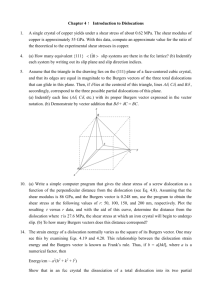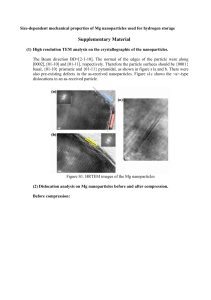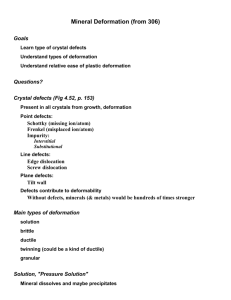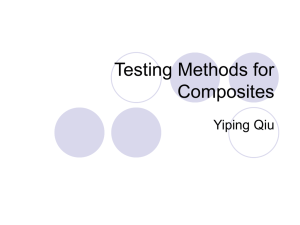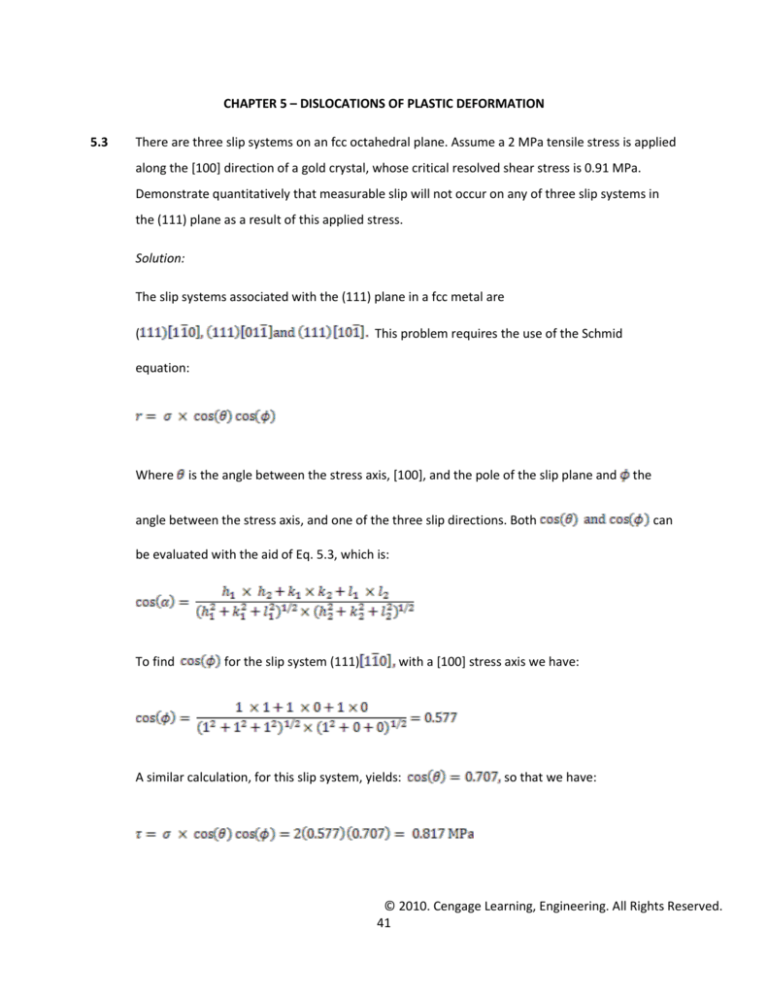
CHAPTER 5 – DISLOCATIONS OF PLASTIC DEFORMATION
5.3
There are three slip systems on an fcc octahedral plane. Assume a 2 MPa tensile stress is applied
along the [100] direction of a gold crystal, whose critical resolved shear stress is 0.91 MPa.
Demonstrate quantitatively that measurable slip will not occur on any of three slip systems in
the (111) plane as a result of this applied stress.
Solution:
The slip systems associated with the (111) plane in a fcc metal are
(
This problem requires the use of the Schmid
equation:
Where
is the angle between the stress axis, [100], and the pole of the slip plane and
angle between the stress axis, and one of the three slip directions. Both
the
can
be evaluated with the aid of Eq. 5.3, which is:
To find
for the slip system (111)
with a [100] stress axis we have:
A similar calculation, for this slip system, yields:
so that we have:
© 2010. Cengage Learning, Engineering. All Rights Reserved.
41
In the same manner we find that for the slip system (111)
and for the (111)
system:
Note that the resolved shear stress on all three of the slip systems is less than the critical
resolved shear stress of 0.91 MPa. As a consequence, the applied stress will not cause slip on
any of the slip systems.
5.5
Deformation twins are also able to form along the {111} planes of fcc crystals, as a result of the
application of a shear stress across this type of plane. In twinning, the shear directions are
.
(a) Prove, using Eq. 5.3, that the
are directions that lie in the (111) plane.
(b) Determine the Schmid factors for the (111)
twinning
systems if a tensile stress is applied along the [711] direction.
Solution:
(a) For a direction to lie in a plane, the dot product of the direction and the pole of the plane
must equal zero. Thus, consider the dot product of the
direction, and the [111] pole;
and for the other system:
© 2010. Cengage Learning, Engineering. All Rights Reserved.
42
Consequently, we may conclude that both of these directions lie in the (111) plane.
(b) First consider the Schmid factor for the
system. The cosine of the angle
between the pole of the twinning plane, [111], and the [711] stress axis is given by:
and the cosine of the angle
between the [711] stress axis, and the
twinning shear
direction is:
And the Schmid factor is:
If we let
the
represent the angle between the stress axis and the twinning shear direction in
twin system, it may be shown that:
So that the Schmid factor for the
twinning system is
Finally, it may be shown that the Schmidt factor for the
twinning system, when
the stress axis is along [711] is:
© 2010. Cengage Learning, Engineering. All Rights Reserved.
43
5.8
A 10 mm diameter zinc crystal has a longitudinal axis that makes an angle of 85 degrees with
the pole of the basal plane, and a 7 degree angle with the closest
slip direction in the
basal plane. If the critical resolved shear stress of zinc is 0.20 MPa, at what axial load would the
crystal begin to deform by basal slip: (a) newtons, (b) kilograms force?
Solution:
The Schmid equation is:
In this equation the only unknown is , the applied tensile stress. Solving for
and substituting
into this equations for , the critical resolved shear stress, and the values of the angles
yields:
Note: 2.31 MPa =
. Let p represent the load. Then, since 10 mm = 0.01 m, the
cross-section area of the specimen will be
. The load p is accordingly:
(a)
(b)
5.11
The total line length of the dislocations in a 4 cm by 4 cm TEM photograph of a metal foil, taken
at a magnification of 25,000X, is 400 cm. The foil imaged by the picture had a thickness of 300
nm. Determine the disloaction density in the foil.
Solution:
© 2010. Cengage Learning, Engineering. All Rights Reserved.
44
The total area of the photograph is 0.04 m by 0.04 m. This corresponds to an area:
The volume of the foil, V, is equal to this area multiplied by the foil thickness,
and is
. The length of the dislocations in this volume is:
The dislocation density, p, may now be calculated:
5.17
Johnston and Gilman have reported that in a grown LiF crystal, subjected to a constant stress of
the dislocation velocity at 249.1 K was
and at 227.3 K the velocity was
They also observed
that their data suggested an Arrhenius relationship between the dislocation velocity and the
absolute temperature, so that one might write
where v is the dislocation
velocity, A a constant of proportionality, Q an effective activation energy in J per mole, and R the
international gas constant (8.314 J per mole
K). Use the velocity versus temperature data of
Johnston and Gilman, given above, to determine Q and A for their LiF crystal, stressed at 1100
. Note that Q may be obtained using the relation:
Once Q has been obtained, A may be determined by substitution into the Arrhenius equation.
© 2010. Cengage Learning, Engineering. All Rights Reserved.
45
Solution:
Given:
Now solving the above equation for Q, and substituting these data into this equation yields:
Next to obtain A use:
and solve for A:
5.19
A typical cross-headed speed in a tensile machine is 0.5 cm per minute.
(a) What is the nominal engineering strain rate imposed by this cross-head speed on a typical
engineering tensile specimen with a 5 cm gage length?
(b) Estimate the dislocation velocity that would be obtained with this strain rate in an iron
specimen, with a dislocation density of
. Assume that the Burgers vector of iron is
0.248 nm.
(c) If a very slow tensile test at a strain rate of
is used, what dislocation velocity would be
expected in the specimen?
Solution:
© 2010. Cengage Learning, Engineering. All Rights Reserved.
46
(a)
(b)
Where is the strain rate, the dislocation density, b the Burgers vector, and v the dislocation
density.
Solving for v, and substituting the given values of p, b, and v give:
(c)
5.21
A tensile test was made on a tensile specimen, with a cylindrical gage section which had a
diameter of 10 mm, and a length of 40 mm. After fracture, the length of the gage section was
found to be 50 mm, the reduction in area 90 percent, and the load at fracture 1000 N. Compute:
(a) The specimen elongation.
(b) The engineering fracture stress.
(c) The true fracture stress, ignoring the correctyion for triaxiality at the neck.
(d) The true strain at the neck.
Solution:
(a) The specimen elongation is
(b) The engineering fracture stress,
area,
, equals the fracture load,
divided by the original specimen
, or:
© 2010. Cengage Learning, Engineering. All Rights Reserved.
47
(c) The reduction in area, RA, is defined as the initial area, minus the final area, divided by the initial
area or:
where
, thus:
The true stress at fracture is equal to the load, P, divided by
or:
(d) The true stress at fracture is given by the equation:
5.23
The slope, m, of the curve drawn through the data points in Fig. 5.35 is approximately equal to
using the units in the figure. Compute the fractional increase in the
dislocation density that would correspond to an increase in flow stress from 588 to 784 MPa
(use the titanium data of Jones and Conrad).
Solution:
Since the data in Fig. 5.35 are given in
784 MPa into
units, first convert the given stresses, 588 and
. This may be done by dividing by the factor 9.81. Thus, 588 MPa = 60
© 2010. Cengage Learning, Engineering. All Rights Reserved.
48
and 784 MPa = 80
. Next use the equation relating the stress to the square
root of the dislocation density.
Now solve for .
where
is the intercept of the straight line, through the data in Fig. 5.35, with the stress axis.
The value of
is 39
and
Accordingly for the 60
stress we have:
A similar calculation for the dislocation density at the 80
stress yields:
The ratio of these two dislocation denstities is:
© 2010. Cengage Learning, Engineering. All Rights Reserved.
49

